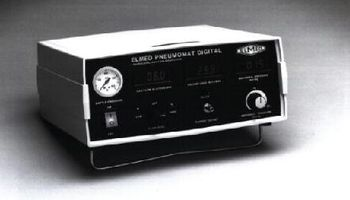Elmed - PNEUMOMAT DIGITAL 52-5100
by Elmed


Incubator
The ELMED PNEUMOMAT DIGITAL represents the latest in design, features and construction in laparoscopic insufflators. The automatic abdominal static pressure regulator will prevent the ELMED PNEUMOMAT DIGITAL from delivering any additional CO2, to the patient when the interabdominal back pressure is above the selected pressure. The digital flow counter will display in liters per minute the volume of gas used. High flow electronic insufflators operate on an impulse system, which typically initiate an impulse cycle every 6-10 seconds. Many of the competitors' systems can deliver up to 140 mm Hg pressure (above the patient's systolic blood pressure). The maximum impulse pressure of the ELMED PNEUMOMAT DIGITAL is 48 mm Hg under any circumstance. The manual back-up pressure release mechanism insures safety. The ELMED PNEUMOMAT DIGITAL samples the patient's pneumoperitoneal pressure every 1.5 seconds. This defeats any false back-pressure reading caused by the patient's respiration cycle, resulting in a more consistent pneumoperitoneal pressure. CO2 insufflators for diagnostic and therapeutic laparoscopy have been in use for over 20 years now. The fact that carbon dioxide creates a non-explosive environment is undisputed and considered safer with regard to embolism than room air. The possibility of gas embolism is the main reason for the generalized use of C02 for the creation of the pneumoperitoneum. It has been demonstrated that the injection of as much as 200 cc of CO2 per minute in the veins is not lethal, while 200 cc of air may cause immediate death. This is explained by the great solubility of C02 in the plasma. (Palmer) Another reason for use of CO2, is its rapid resorption by the tissue. This explains the absence of shoulder pain when the patient stands up a few hours after laparoscopy. The rapid resorption of the CO2 by the peritoneum may provoke hypercardia with cardiorespiratory changes. The anesthesiologist should know these changes well in order to interpret them as symptoms of possible gas embolism. The only pathognomonic symptom of gas embolism is a special bubble-like noise during auscultation of the heart. This must be monitored along with other vital symptoms. The cardio respiratory changes due to hypercardia may be dangerous to some patients with previous cardiorespiratory diseases, especially if combined with the Trendelenburg position and over distention of the abdomen. (Palmer) The output pressure of the insufflator must be carefully monitored and controlled. Generally, a gas pressure of 20 mm Hg. and a flow rate of 1 liter per minute is administered for laparoscopic tubal sterilization. This example is a relatively simple procedure where very little gas is lost. When smoke evacuation is utilized in such procedures as contemporary laparoscopic, pelviscopic or laparoscopic cholecystectomy, the vast majority of the gas delivered by the insufflator is simply ventilated back into the air. Therefore, the amount of gas required for these procedures is unpredictable.[list] [/list] The gas flow must accommodate the amount of CO2 which is evacuated. Therefore, an insufflator designed for laparoscopy or pelviscopy must deliver a high flow of at least 5 liters per minute. Since the criteria for the amount of gas required for a procedure, may be between 10 and 100 liters and since the amount of gas being absorbed by the peritoneum is impossible to establish during rapid evacuation and insufflation, the actual recording of the amount of CO2 used during the course of the procedure has no significance for either safety or liability reasons. ELMED offers both non-electric insufflators and electronic digital insufflators to satisfy the demands of our customers.